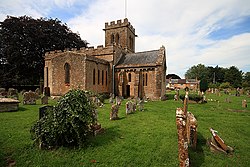Stoke-sub-Hamdon
| Stoke-sub-Hamdon | |
| Somerset | |
|---|---|
 Church of St Mary the Virgin | |
| Location | |
| Grid reference: | ST475175 |
| Location: | 50°57’16"N, 2°44’56"W |
| Data | |
| Population: | 1,968 (2011[1]) |
| Post town: | Stoke-sub-Hamdon |
| Postcode: | TA14 6 |
| Dialling code: | 01935 |
| Local Government | |
| Council: | South Somerset |
| Parliamentary constituency: |
Yeovil |
Stoke-sub-Hamdon (or Stoke sub Hamdon), also known as Stoke under Ham,[2] is a large village and parish in Somerset. It is situated five miles west of Yeovil, with which it is linked by the A3088 road. The parish is located near the River Parrett, and includes the village of East Stoke.
History
The village stretches around Ham Hill which is a geological Site of Special Scientific Interest, Iron Age hill fort, Roman site, and country park. The hill has given its name to the distinctive quarried hamstone which is quarried from a ridge of sandy limestone rock that is elevated above the lower lying clay vales and nearby Somerset Levels. It is of particular importance to geologists because of the assemblages of fossils which it contains, the sedimentary features which it displays and the way it relates to other rocks of equivalent age in the close vicinity.[3] The Bronze Age and Iron Age hill fort was occupied by the Durotriges tribe. A Roman milestone was found at Venn Bridge in 1930: apparently it was made as an element in a colonnade and afterwards converted to a milestone inscribed with the name of the emperor Flavius Severus who ruled in AD 305-306.[4]
In the 10th century the estate passed to Glastonbury Abbey, but after the Norman Conquest was held by Robert, Count of Mortain and granted to Robert FitzIvo. It then passed down through the Beauchamps of Hatch, becoming known as Stoke Beauchamp. It was acquired by the Duchy of Cornwall in 1443 and is still held by the Duchy.[5] The parish of Stoke forms part of Tintinhull Hundred.[6]
The village is the site of the 14th century Stoke sub Hamdon Priory which is a former priest's house of the chantry chapel of St Nicholas, which was destroyed after the dissolution of the monasteries. The priory has been owned by the National Trust since 1946,[7] and designated by English Heritage as a Grade-I listed building.[8]
Religious sites
The church, dedicated to St Mary the Virgin, dates from the 12th century,[9] and has a tower and five bells. It shows various mediæval carving including abstract corbels, an astrological tympanum, and St Michael slaying the dragon. Two of the carvings are thought to be Sheela na Gigs.[10]
References
- ↑ "Statistics for Wards, LSOAs and Parishes — SUMMARY Profiles" (Excel). Somerset Intelligence. http://www.somersetintelligence.org.uk/files/Somerset%20Census%20Key%20Statistics%20-%20Summary%20Profiles.xls. Retrieved 4 January 2014.
- ↑ A History of the County of Somerset: Volume 3. Victoria County History. 1974. pp. 235–249. http://www.british-history.ac.uk/vch/som/vol3/pp235-249. Retrieved 3 January 2015.
- ↑ "Ham Hill". http://www.english-nature.org.uk/citation/citation_photo/1000144.pdf. Retrieved 2006-07-17.
- ↑ Collingwood, R. G.; =Wright, R. P. (1965). The Roman Inscriptions of Britain. I: Inscriptions on stone. Oxford: Clarendon Press. p. 694.
- ↑ Bush, Robin (1994). Somerset: The Complete Guide. Dovecote Press. pp. 197–198. ISBN 1-874336-26-1.
- ↑ "Somerset Hundreds". GENUKI. http://www.genuki.org.uk/big/eng/SOM/Miscellaneous/. Retrieved 22 October 2011.
- ↑ "Stoke sub Hamdon Priory". National Trust. http://www.nationaltrust.org.uk/main/w-vh/w-visits/w-findaplace/w-stokesubhamdonpriory/. Retrieved 2007-11-11.
- ↑ "The Priory, or Parsonage Farmhouse". Images of England. http://www.imagesofengland.org.uk/details/default.aspx?id=441493. Retrieved 2007-11-11.
- ↑ "Church of St Mary the Virgin". Images of England. English Heritage. http://www.imagesofengland.org.uk/Details/Default.aspx?id=440779. Retrieved 2008-10-16.
- ↑ "The Stoke sub Hamdon Figure". Sheela Na Gig Project. http://www.sheelanagig.org/index.html#http://www.sheelanagig.org/SheelaStokeSubHamdon.htm. Retrieved 2007-11-11.
Outside links
| ("Wikimedia Commons" has material about Stoke-sub-Hamdon) |